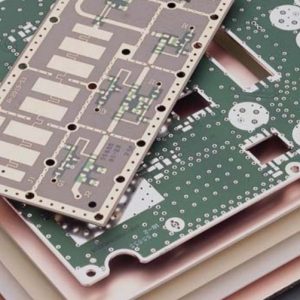A high-frequency board is a special copper-clad board with a high-frequency microwave substrate, also called a high-frequency microwave printed board, further processing can be manufactured into high-frequency PCB boards. The use of Rogers high-frequency materials made into Rogers boards, widely used in communications base stations and antennas aviation, high demand, market prospects Good. As the world's leading supplier of specialty boards, Rogers boards have a global market share of more than 50% and have 20 years of experience in the base station antenna RF field. As a leading supplier of specialty plates, Rogers has a global market share of more than 50% and 20 years of experience in the field of base station antenna RF. - Rogers substrate

Rogers Ro4350 HF material is a glass fiber reinforced (non-PTFE) hydrocarbon/ceramic laminate designed for high volume, high-performance commercial applications. Ro4350 is designed to provide superior RF performance and cost-effective circuit production. The result is a low-loss material that can be used with standard epoxy/glass (Fiberglass) laminates. standard epoxy/glass (FR4) process at a competitive price. As operating frequencies increase to 500 MHz or higher, designers The RO4350PCB has the features required by RF microwave developers to achieve repeatable design impedance for filters, coupling networks, and networks. and networks for repeatable design of impedance-controlled transmission lines. The low dielectric loss allows the use of RO4350 series materials in many applications where higher operating frequency limits the use of laminated materials for conventional printed circuit boards. The temperature coefficient of the dielectric constant is one of the lowest of any printed circuit. The temperature coefficient of the dielectric constant is one of the lowest of all printed circuits and the dielectric constant is stable over a wide frequency range making it an ideal substrate for broadband applications.
Hole quality should be used to determine tool life rather than tool wear.RO4350 material provides good drilling when drilled with epoxy/glass-compliant drills. provide good hole quality when drilled. When compared to Ep-Oxy/glass, the roughness of the material holes RO4350 does not increase significantly when using this tool increase. Typical values vary between 8 and 25 microns regardless of the number of visits (evaluated up to 8,000 visits). The roughness is directly related to the ceramic filler size is directly related to the size of the ceramic filler and provides a favorable morphology for adhesion to the pore walls. It has been found that holes drilled for epoxy/glass plate conditions have good hole quality with a strike rate greater than 2000.
Coefficient of Thermal Expansion (CTE) RO4350 material offers several key advantages to circuit designers. The material RO4350 has a coefficient of expansion similar to that of copper, the This makes the material visible.
Dimensional Stability
This is an essential characteristic for building hybrid dielectric multilayers. The low CTE of RO4350 laminates on the Z-axis provides reliable through-hole quality, even in harsh thermal shock applications. RO4350 series materials have a TG of over 280°C (536°F), so their expansion characteristics remain stable at all process temperatures in the circuit. RO4350 series laminates can be easily converted to printed circuit boards using standard FR4 circuit board processing techniques. boards using standard FR4 circuit board processing techniques. Unlike high-performance PTFE-based materials, RO4350 series laminates do not require special preparation processes such as sodium etching. The material is a rigid, thermally stable laminate that can be processed with automated handling systems and washers used to create copper surfaces.
Availability
RO4350 laminates are currently available in a variety of 1080 options and 1674 glass fabric models, all of which meet the same electrical performance specifications for lamination. Designed as a direct replacement for RO4350 material, RO4350 laminates utilize RoHS-compliant flame retardant technology for applications requiring UL 94V Application-0 certification. These materials meet the requirements of IPC4003/10 monolithic RO4003C and /11 RO4350.
Fabrication Guidelines
RO4350 high-frequency circuit materials have been developed to provide high-frequency performance comparable to woven PTFE glass substrates, simplifying the manufacturing process Ring RO4350 is a thermoset material filled with a hydrocarbon/glass fiber reinforced ceramic with a very high glass transition temperature (TG> 280°F). glass transition temperature is very high (TG> 280°C). Unlike PTFE-based microwave materials, no special treatment or passage is required. As a result, processing and assembly costs for RO4350 material circuits and assembly costs are comparable to epoxy/glass laminates. Here are some basic tips for handling RO4350 double-sided printing plates. In general, the parameters and processing methods used for epoxy/glass plates can be used to process the RO4350 plates.
Inlet/Outlet Material
Inlet and outlet materials must be flat and rigid to minimize copper burrs. Recommended input materials are aluminum and rigid laminate (0.254 to 0.635 mm). Most conventional starting materials with or without aluminum coating are suitable.
Maximum cell height
The thickness of the material to be drilled must not exceed 70% of the trench length. This includes the thickness of the input material and penetration into the substrate.
Perforation
Surface velocities over 500 SFM and chip loads less than 0.05 mm (0.002") should be avoided if possible.
Contact OPCBA.COM to inquire about Rogers substrate.

分享到: